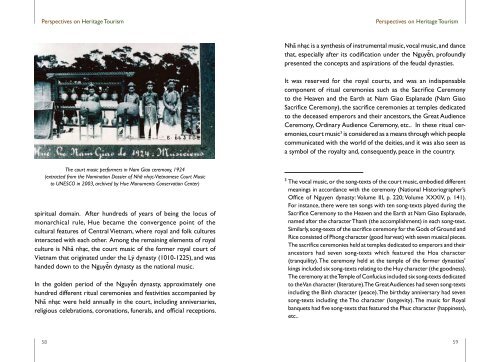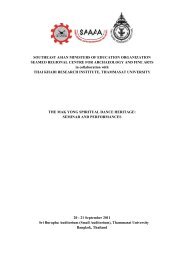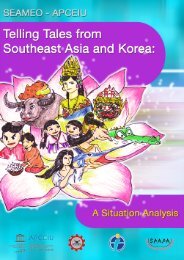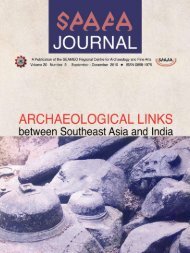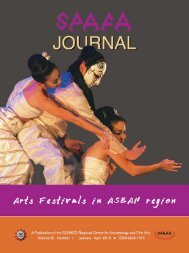Perspectives on Heritage Tourism - Seameo-SPAFA
Perspectives on Heritage Tourism - Seameo-SPAFA
Perspectives on Heritage Tourism - Seameo-SPAFA
Create successful ePaper yourself
Turn your PDF publications into a flip-book with our unique Google optimized e-Paper software.
<str<strong>on</strong>g>Perspectives</str<strong>on</strong>g> <strong>on</strong> <strong>Heritage</strong> <strong>Tourism</strong><br />
<str<strong>on</strong>g>Perspectives</str<strong>on</strong>g> <strong>on</strong> <strong>Heritage</strong> <strong>Tourism</strong><br />
Nhã nhạc is a synthesis of instrumental music, vocal music, and dance<br />
that, especially after its codificati<strong>on</strong> under the Nguyê˜n, profoundly<br />
presented the c<strong>on</strong>cepts and aspirati<strong>on</strong>s of the feudal dynasties.<br />
It was reserved for the royal courts, and was an indispensable<br />
comp<strong>on</strong>ent of ritual cerem<strong>on</strong>ies such as the Sacrifice Cerem<strong>on</strong>y<br />
to the Heaven and the Earth at Nam Giao Esplanade (Nam Giao<br />
Sacrifice Cerem<strong>on</strong>y), the sacrifice cerem<strong>on</strong>ies at temples dedicated<br />
to the deceased emperors and their ancestors, the Great Audience<br />
Cerem<strong>on</strong>y, Ordinary Audience Cerem<strong>on</strong>y, etc.. In these ritual cerem<strong>on</strong>ies,<br />
court music 3 is c<strong>on</strong>sidered as a means through which people<br />
communicated with the world of the deities, and it was also seen as<br />
a symbol of the royalty and, c<strong>on</strong>sequently, peace in the country.<br />
The court music performers in Nam Giao cerem<strong>on</strong>y, 1924<br />
(extracted from the Nominati<strong>on</strong> Dossier of Nhã nhạc-Vietnamese Court Music<br />
to UNESCO in 2003, archived by Hue M<strong>on</strong>uments C<strong>on</strong>servati<strong>on</strong> Center)<br />
spiritual domain. After hundreds of years of being the locus of<br />
m<strong>on</strong>archical rule, Hue became the c<strong>on</strong>vergence point of the<br />
cultural features of Central Vietnam, where royal and folk cultures<br />
interacted with each other. Am<strong>on</strong>g the remaining elements of royal<br />
culture is Nhã nhạc, the court music of the former royal court of<br />
Vietnam that originated under the Lý dynasty (1010-1225), and was<br />
handed down to the Nguyê˜n dynasty as the nati<strong>on</strong>al music.<br />
In the golden period of the Nguyê˜n dynasty, approximately <strong>on</strong>e<br />
hundred different ritual cerem<strong>on</strong>ies and festivities accompanied by<br />
Nhã nhạc were held annually in the court, including anniversaries,<br />
religious celebrati<strong>on</strong>s, cor<strong>on</strong>ati<strong>on</strong>s, funerals, and official recepti<strong>on</strong>s.<br />
3<br />
The vocal music, or the s<strong>on</strong>g-texts of the court music, embodied different<br />
meanings in accordance with the cerem<strong>on</strong>y (Nati<strong>on</strong>al Historiographer’s<br />
Office of Nguyen dynasty: Volume III, p. 220; Volume XXXIV, p. 141).<br />
For instance, there were ten s<strong>on</strong>gs with ten s<strong>on</strong>g-texts played during the<br />
Sacrifice Cerem<strong>on</strong>y to the Heaven and the Earth at Nam Giao Esplanade,<br />
named after the character Thanh (the accomplishment) in each s<strong>on</strong>g-text.<br />
Similarly, s<strong>on</strong>g-texts of the sacrifice cerem<strong>on</strong>y for the Gods of Ground and<br />
Rice c<strong>on</strong>sisted of Ph<strong>on</strong>g character (good harvest) with seven musical pieces.<br />
The sacrifice cerem<strong>on</strong>ies held at temples dedicated to emperors and their<br />
ancestors had seven s<strong>on</strong>g-texts which featured the Hoa character<br />
(tranquility). The cerem<strong>on</strong>y held at the temple of the former dynasties’<br />
kings included six s<strong>on</strong>g-texts relating to the Huy character (the goodness).<br />
The cerem<strong>on</strong>y at the Temple of C<strong>on</strong>fucius included six s<strong>on</strong>g-texts dedicated<br />
to the Van character (literature). The Great Audiences had seven s<strong>on</strong>g-texts<br />
including the Binh character (peace). The birthday anniversary had seven<br />
s<strong>on</strong>g-texts including the Tho character (l<strong>on</strong>gevity). The music for Royal<br />
banquets had five s<strong>on</strong>g-texts that featured the Phuc character (happiness),<br />
etc..<br />
58<br />
59


